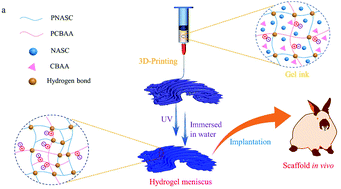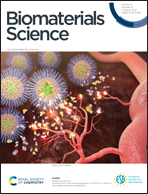3D printing of lubricative stiff supramolecular polymer hydrogels for meniscus replacement†
Abstract
3D printing of a stiff and lubricative hydrogel-based meniscus substitute has been challenging since printability and stiffness compromise each other. In this work, based on an upgraded self-thickening and self-strengthening strategy, a unique multiple H-bonding monomer N-acryloylsemicarbazide (NASC) is firstly copolymerized with a super-hydrophilic monomer carboxybetaine acrylamide (CBAA) in dimethyl sulfoxide (DMSO)/H2O to form a soft poly(NASC-co-CBAA) gel, in which PCBAA serves to weaken the H-bonding interaction and avoid hydrophobic phase separation. The poly(NASC-co-CBAA) gel is then loaded with concentrated NASC and CBAA, followed by heating to form a thickening sol ink, which is printed into different objects that are further photoirradiated to initiate the copolymerization of entrapped NASC and CBAA, resulting in the formation of a high performance hydrogel with a Young's modulus of 10.98 MPa, tensile strength of 1.87 MPa and tearing energy of 5333 J m−2 after DMSO is completely replaced with water, due to the re-establishment of NASC H-bonds. Importantly, PCBAA affords high lubricity in printed hydrogels. The printed PNASC–PCBAA meniscus substitute can substitute rabbit's native meniscus and ameliorate the cartilage surface wear within a set 12-week time window, portending great potential as a meniscal substitute and other soft-supporting tissue scaffolds.



 Please wait while we load your content...
Please wait while we load your content...